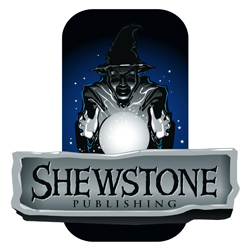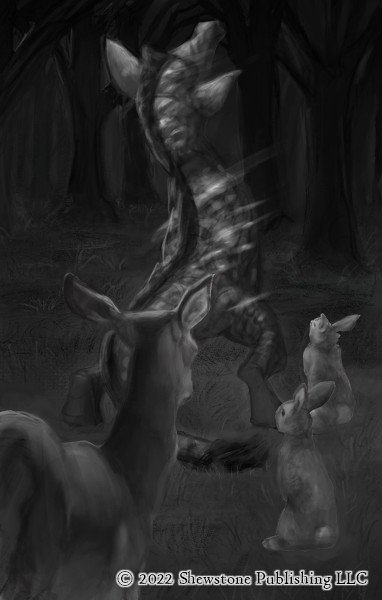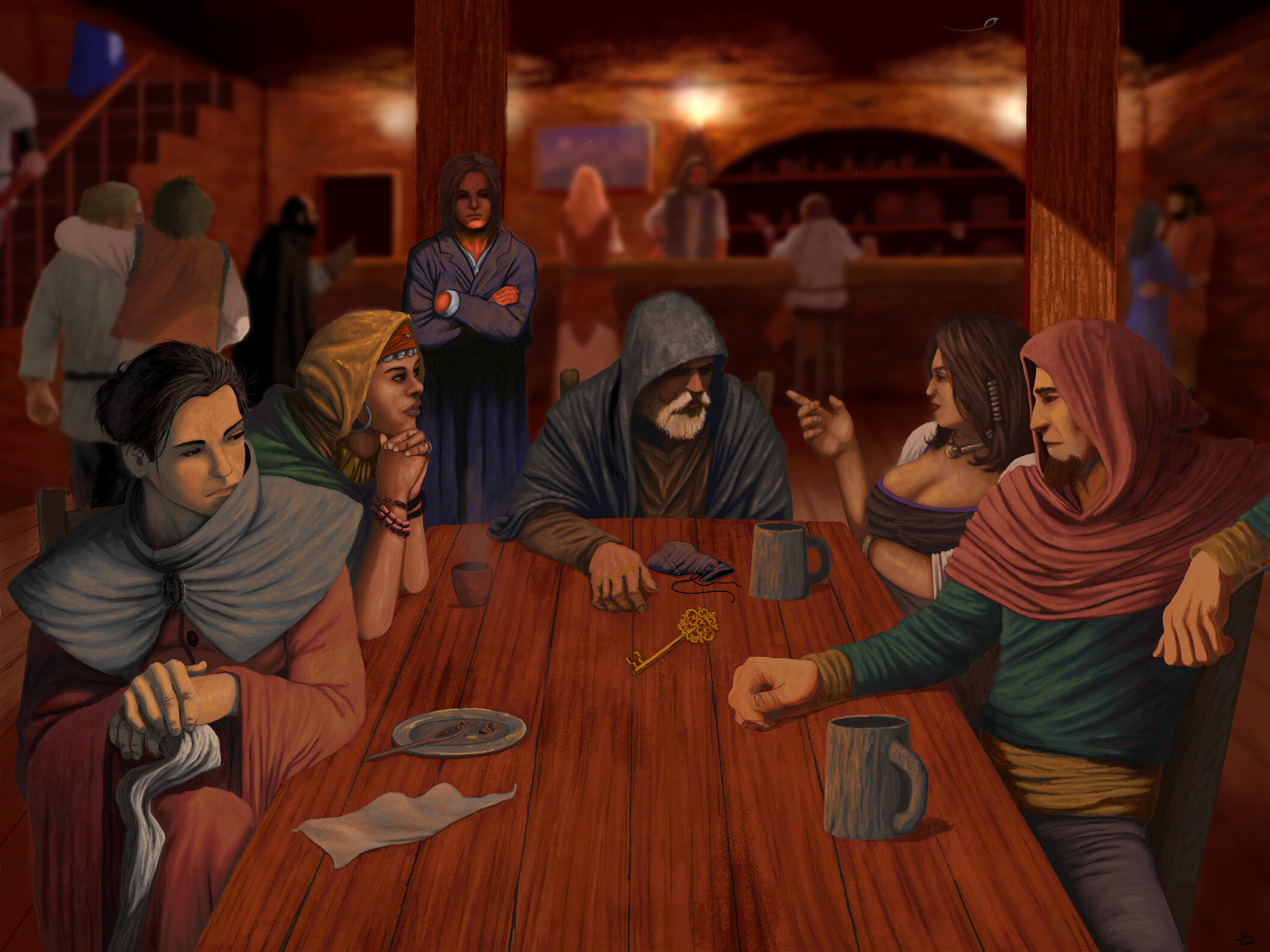Last week I posted in detail about the playtest of the basilisk for A Bestiary of Enchanted England. The same weekend, my trusty former college gaming buddies and I also tried out three other creatures from the Bestiary: the bugbear, unicorn, and scitalis. I’m not planning to post about those creatures in the same detail because it that basilisk post took a couple of hours to write. I do think it’s worthwhile to tell you about the outcomes because it gives insight into how a game designer uses playtest feedback.
The Bugbear: Mood is Key
We posted an early version of the Bugbear as a Halloween challenge for the Bestiary Kickstarter. Designer Mark Lawford interpreted the folklore to create a creature rather different from what appears in Dungeons & Dragons. Our bugbear is a psychological thriller. It’s all about being scary. In fact, part of the theme of the monster is that it’s a paper tiger: it flees as soon as it encounters resistance.
We used one of the plot hooks Mark created: a playwright was holed up in his room, afraid to come out because he was tormented each night by bugbears. We had four player characters and I knew a single bugbear would be no match for them. I used two.
I was pleased with how easy it was to create the sense of dread by narrating the creepy sounds of the bugbears’ invisible approach. They’re getting closer … you there’s a scratching at the window … someone or something is trying the doorknob. Great stuff, and exactly what we’re looking for in a bugbear experience.
The playtest draft of the bugbear has two powers that both cause fear. One of them uses Fate’s Create an Advantage mechanic to create an Aspect representing the fear. The other is a mental attack. The idea was for it to first use the former power, then the latter. Simple enough.
It didn’t play smoothly. The Create an Advantage power was meant allow for a Will defense. That looks good on paper but it raises a lot of practical questions when there are several PCs in the scene. How do you roll the Defense? I used Teamwork, but a less experienced Fate GM might try rolling Defense individually and be left stuggling with how to handle a Create an Advantage action that worked against some PCs and not others. In our case, the PCs blocked the Create an Advantage action without much trouble. The bugbear was trying to create a situational Aspect to represent its spookiness, but all it ended up doing was wasting its turn.
It already has an Aspect that represents its spookiness: Terrifying … Until Confronted. It would have been more effective for the GM to simply pay a Fate Point to Invoke that instead of spending an Exchange trying to set it up for free. So that’s what we’re recommending now. The spell that sets up an Aspect (“Gnawing Fear”) has been removed, and roleplaying notes updated to say just to Invoke Terrifying … Until Confronted. This results in a tighter design. It also plays more smoothly, requiring no extra dice roll as prelude to the mental attack. That helps the GM preserve the mood.
A designer knows he has achieved perfection not when there is nothing left to add, but when there is nothing left to take away.
The Unicorn: Suprisingly Terrifying
Image source: Wikimedia Commons
If you haven’t read the Bestiary manuscript, you might expect the unicorn to be a gentle beast surrounded by flower and rainbows. That’s very far from how unicorns were portrayed in sixteenth century literature. They’re a symbol of ferocity.
I felt that I had to shatter my players’ preconceptions of what unicorns are like in Magonomia. I read them this bit straight from the text:
Unicorns love getting angry and killing people …
—Timothy Ferguson, A Bestiary of Enchanted England
I sent my players’ wizards on a mission to recapture a unicorn that had “escaped” (it later seemed more likely it had been set loose) from the estate of Henry Percy, the Wizard Earl of Northumberland. They had the sense to ask Earl Percy for some help: horses, skilled huntsmen, and a pack of hounds.
After a skill challenge assisted by several spells, they managed to find the unicorn and set an ambush. It took these mostly nonviolent wizards some doing but they pulled it off. Hardened adventurers would likely have an easier time.
Springing the ambush was another matter. It went sideways, and sorcerer Christopher Hill got gored a little bit. Four wizards who weren’t combat optimized managed to fight the unicorn to a standstill. They probably could have worn it down eventually, but I didn’t have it stick around to get captured. I had it Concede the Conflict and escape into the woods. If we had wanted to spend all afternoon on the unicorn hunt, the PC wizards could have regrouped and tried again. We decided to move on.
Mechanically, the unicorn performed very satisfactorily. It’s deadly to a single character if the character isn’t combat optimized. A group can stand up to it and it can stand up to a group. Once it escapes, it takes teamwork and resourcefulness to track it down.
I passed the unicorn along to editing with no changes. Of course, I might hear a different story from external playtesters, so the unicorn’s statistics aren’t final yet.
The Scitalis: Beware the Disco Ball Crocodile
The scitalis is a creature from medieval bestiaries that’s less familiar than most. It’s a large serpent (which, in the 16th century, was a synonym for “reptile” not necessarily “snake”) covered in shimmering, iridescent scales. I’ll admit I made the mistake of calling it a “disco ball crocodile” out loud, but my players didn’t keep snickering very long. This turned out to be the deadliest creature we’ve playtested so far.
I knew this was going to be a stiff fight, so I gave the player-wizards a straightforward mission: slay the “dragon” that’s been eating livestock and occasional travelers. They armed themselves with boar spears (Weapon: 3) but the only PC who’s Good (+3) at Fighting was absent that day.
According to folklore, the scitalis’s shimmering scales literally stun onlookers. I thought this would be weak sauce, but it was very effective. The way the power is written, the moment you look at the scitalis, you have to make a Will Defense or be entranced. This is a high stakes dice roll. If you fail, all you can do is try again each Exchange to break its hold over you. Meanwhile it has the Aspect Can’t Refuse an Opportunity to Feed.
This creature is kind of the opposite of a basilisk. It doesn’t sound so bad … entrances people who look at it, how quaint … but it’s big, it’s strong, and it can take a beating at least as well as it can dish it out. At first, I thought it would be easy pickings for a couple of arquebusiers, but I no longer think so. If they can see it well enough to shoot at it, they can see it well enough to get entranced. Taking down this serpent will require as much guile as strength.
In the end, our four not-combat-optimized wizards killed the scitalis in slow, gritty, desperate hand-to-and combat, but they carry some scars, both figuratively and literally. The fun of the Scitalis is getting past/around its entrancement ability. I ended up toning down the Scitalis’s Fighting skill slightly because the playtest version died a little too hard.
More Playtesting Ahead
Our last playtest binge focused on combat because that’s where small design mistakes have a big impact on the play experience, like our die-hard scitalis. But the great thing about A Bestiary of Enchanted England is that you can have great stories centered on many of these creatures without ever drawing a sword. There’s more playtesting ahead, and we’re eager for some help! Stop by our Discord server if you’d like to get involved.







